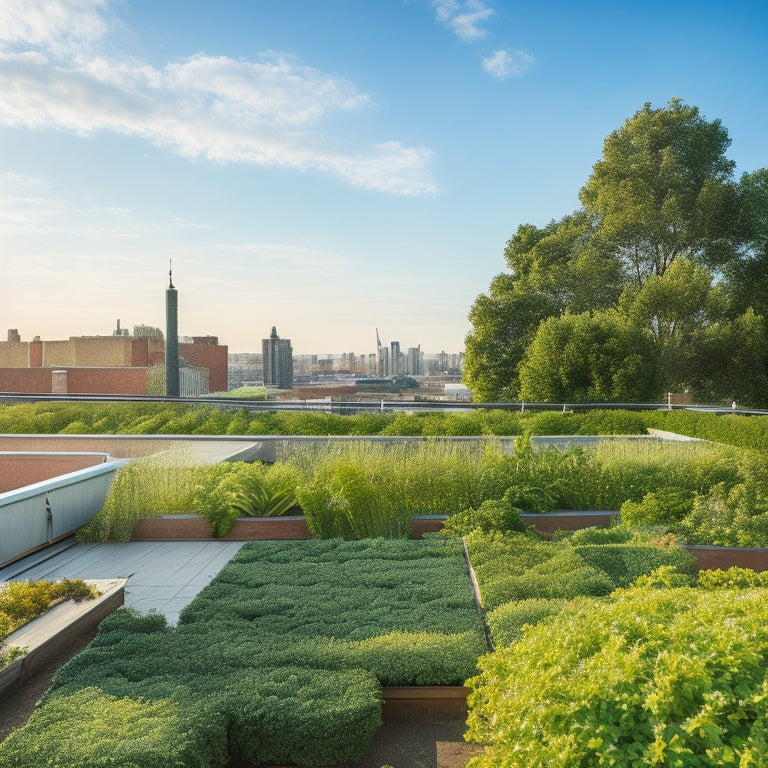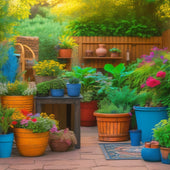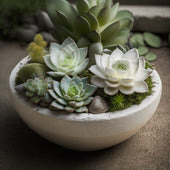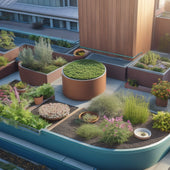
Installing Rooftop Irrigation for Small Veggie Gardens
Share
You'll need to assess your rooftop's capacity to support the weight of an irrigation system, making sure it's structurally sound before installing a system that can efficiently water your small veggie garden. Choose an irrigation system type and materials suitable for your water pressure, flow rate, and soil type. Clear the rooftop surface of debris and check for damage before installing pipes and fittings according to your garden design. Next, set up timers and controllers to maximize water usage based on soil type, climate, and plant variety. You'll need to regularly check and maintain the system to ensure peak performance and get the most out of your rooftop irrigation.
Key Takeaways
• Assess rooftop capacity and structural soundness to ensure safe installation of the irrigation system.
• Choose a suitable irrigation system type and materials based on water pressure, flow rate, and soil type.
• Install irrigation pipes and fittings according to the garden design, ensuring proper water distribution to veggies.
• Set up irrigation timers with schedules tailored to soil type, climate, and plant variety to prevent overwatering or underwatering.
• Regularly maintain the system by inspecting components, cleaning filters, and detecting leaks to ensure optimal performance and water efficiency.
Assessing Your Rooftop's Capacity
Before installing a rooftop irrigation system, you need to determine whether your rooftop can support the weight of the water, soil, and plants, as well as confirm it's structurally sound to handle the added load. This evaluation is essential to guarantee the safety and success of your small veggie garden.
Conduct a thorough drainage inspection to identify any potential issues. Check for signs of water damage, cracks, or sagging, which can indicate weaknesses in your rooftop's structure.
Calculate your rooftop's weight capacity by factoring in the weight of the soil, plants, and water. This will give you a clear understanding of what your rooftop can handle.
Next, evaluate the sun exposure of your rooftop. Most vegetables require at least six hours of direct sunlight per day. Choose plant varieties that thrive in your rooftop's specific sun conditions. Consider the mature size of your plants and leave sufficient space for growth and air circulation.
Choosing the Right Irrigation System
When selecting the appropriate irrigation system for your rooftop vegetable garden, you'll need to weigh several key factors.
You'll want to identify the type of system that best fits your garden's requirements, whether it's a drip, sprinkler, or micro-irrigation system.
You'll also need to choose materials that can withstand rooftop conditions and make sure the system can operate within your rooftop's water pressure range.
Types of Irrigation Systems
You'll need to select an irrigation system that suits your rooftop veggie garden's unique requirements, taking into account factors such as water pressure, flow rate, and soil type.
Two popular options for small gardens are drip irrigation and soaker hoses. Drip irrigation delivers water directly to the roots, reducing evaporation and runoff. Soaker hoses, on the other hand, release water slowly, allowing it to seep into the soil. Both systems conserve water and reduce waste.
If you're looking for a more sustainable approach, consider harvesting rainwater with rain barrels. This free water source can be used to supplement your irrigation system, reducing your reliance on municipal water. Watering cans are another option, providing a simple, low-tech way to deliver water directly to your plants.
When choosing an irrigation system, consider your garden's specific needs, including the type of plants, soil, and climate. By selecting the right system, you'll be able to enjoy a thriving, water-efficient rooftop garden.
Irrigation System Materials
To optimize the performance of your rooftop veggie garden's irrigation system, selecting the right materials is pivotal, as they can significantly impact the system's effectiveness and water efficiency. You want to make sure that your system delivers water precisely where it's needed, without wasting a single drop.
Here are some essential materials to contemplate:
-
Drip irrigation tubing: This type of tubing delivers water directly to the roots of your plants, reducing evaporation and runoff.
-
Rain barrels: Harvesting rainwater is a great way to supplement your irrigation system and reduce your water bill. Be sure to choose barrels that are specifically designed for rooftop collection.
-
Water-efficient emitters: These devices regulate water flow and prevent clogging, ensuring that your plants receive the right amount of water.
- UV-resistant hoses: These hoses can withstand the harsh rooftop environment, resisting cracks and damage from UV exposure.
System Water Pressure
Your rooftop veggie garden's irrigation system relies on a delicate balance of water pressure to function efficiently, and selecting the right system hinges on understanding the pressure needs of your specific setup. The pressure of your water supply will determine the type of irrigation system you need.
If your water pressure is too high, it can damage your system or lead to water waste. On the other hand, low pressure can result in insufficient water flow, leaving your plants parched.
You'll need to determine the static pressure of your water supply, which is the pressure when no water is flowing. You can use a pressure gauge to measure this. Then, consider the pressure losses that occur as water flows through your system, such as through pipes and fittings. Adjusting pressure regulators can help offset these losses.
Preparing the Rooftop Surface
Before you start installing your rooftop irrigation system, you'll need to prepare the rooftop surface to guarantee a successful and safe setup.
You'll want to begin by conducting a thorough rooftop inspection to identify any potential issues or hazards.
Next, you'll need to remove any debris, such as leaves or branches, to create a clean and even surface for your irrigation system.
Rooftop Inspection Needed
Inspect your rooftop carefully for damaged, rotten, or missing shingles, as well as signs of sagging or unevenness, which can compromise the structural integrity of your rooftop irrigation system. This critical step ensures rooftop safety and prevents potential hazards during installation and operation.
To guarantee a thorough inspection, check for:
-
Loose or missing roofing fasteners, which can lead to water seepage and further damage.
-
Cracked or broken roofing tiles, which can cause leaks and compromise the system's performance.
-
Signs of pest or animal infestation, such as nests or burrows, which can damage the rooftop and irrigation system.
- Rust or corrosion on metal components, which can weaken the structure and lead to costly repairs.
Rooftop Debris Removal
Now that you've confirmed your rooftop is structurally sound, clear the surface of debris, including leaves, branches, and other obstructions that could interfere with your irrigation system's performance. Effective debris management is crucial to guarantee your rooftop irrigation system functions optimally. Remove any loose materials, such as twigs, rocks, or broken tiles, that could clog your system's pipes or nozzles.
| Debris Type | Removal Tips |
|---|---|
| Leaves | Use a leaf blower or a soft-bristled broom to sweep away leaves and debris from the rooftop surface. |
| Branches | Cut or prune branches that overhang the rooftop to prevent damage to your irrigation system or the roof itself. |
| Gutters | Clean gutters and downspouts regularly to ensure water flows freely and doesn't accumulate, causing damage to your roof or walls. |
| Vegetation | Control vegetation growth on the rooftop by removing weeds and debris that can clog your irrigation system or compromise the roof's structural stability. |
Installing Irrigation Pipes and Fittings
You'll need to layout and connect the irrigation pipes and fittings according to your rooftop garden's specific design and water requirements. This is a pivotal step in ensuring that your plants receive the right amount of water at the right time.
Here are some key considerations to keep in mind:
-
Pipe layout: Plan the route of your pipes to minimize kinking, bending, and damage. Make sure to label each pipe to avoid confusion later on.
-
Drip emitters: Space these evenly along the pipes to deliver water directly to the roots of your plants. You can adjust the flow rate based on the specific needs of each plant.
-
Water distribution: Use connectors to branch off into different sections of your garden, ensuring that each area receives an equal amount of water.
- Fittings and adapters: Choose the right fittings and adapters to connect pipes of different sizes and materials. This will help maintain water pressure and prevent leaks.
Setting Up Timers and Controllers
Set up your timers and controllers to automate watering schedules, guaranteeing your rooftop veggie garden receives the right amount of water at the right time. You'll need to program your timer to match your garden's specific watering needs. Consider factors like soil type, climate, and plant variety when determining the best watering frequency.
| Timer Setting | Watering Frequency | Controller Setting |
|---|---|---|
| Daily | Every 2 hours | 10-minute duration |
| Every other day | Once in the morning | 20-minute duration |
| Weekly | Once a week | 30-minute duration |
| Custom | Based on weather data | Variable duration |
| Manual | As needed | Manual override |
When programming your timer, make sure you set the correct start time, duration, and frequency to avoid overwatering or underwatering. If you notice any issues with your system, refer to the troubleshooting guide provided with your controller or timer. Common issues include incorrect timer programming, clogged nozzles, or malfunctioning sensors. By following these steps and monitoring your system regularly, you'll be able to enjoy a bountiful harvest from your rooftop veggie garden.
Maintaining the Irrigation System
Regular checks of your rooftop irrigation system's components, including timers, controllers, and nozzles, are essential to guarantee consistent performance and prevent water waste. You'll want to verify that every part is functioning correctly to avoid overwatering or underwatering your precious veggies.
To maintain your rooftop irrigation system, follow these key steps:
-
Drip line maintenance: Regularly inspect and clean your drip lines to prevent clogging and ensure even water distribution.
-
Watering schedule adjustment: Adjust your watering schedule according to weather conditions, soil moisture, and plant growth to optimize water usage.
-
Filter cleaning: Clean your irrigation system's filters regularly to prevent sediment buildup and verify proper water flow.
- Leak detection: Inspect your system for signs of leaks, such as water pooling or uneven soil moisture, and address them promptly to prevent water waste.
Frequently Asked Questions
Can I Use a Rooftop Irrigation System for Flowers and Herbs Too?
You can definitely use a rooftop irrigation system for flowers and herbs too, just adjust the watering schedule for your flower arrangement and make sure your herb garden has a proper drainage system to prevent waterlogged soil.
Will the Irrigation System Affect My Rooftop's Warranty?
Did you know that 70% of homeowners consider their rooftop an essential investment? You'll be relieved to know that most rooftop warranties remain intact with a properly installed irrigation system, but maintenance considerations, like regular inspections, are essential to avoid warranty implications.
Can I Install the System Myself or Do I Need a Professional?
You can attempt a DIY installation, but without expertise, you may void your warranty or compromise the system's efficiency, whereas hiring a professional guarantees a seamless setup, though it'll cost more, you'll gain peace of mind.
How Do I Prevent Mineral Buildup in the Irrigation Pipes?
As you navigate the treacherous waters of piping, remember that mineral buildup is like a silent thief, stealing away your system's efficiency. You'll need to keep a watchful eye on soil pH and water quality to prevent this sneaky saboteur from taking hold.
Are There Any Local Regulations Regarding Rooftop Irrigation Systems?
You'll need to research local regulations, checking for water usage restrictions and permit requirements, ensuring your system complies with ordinances, and obtaining necessary permits to avoid fines and maintain your independence.
Related Posts
-

3 Best DIY Planter Ideas for Backyard Decor
You can elevate your backyard's style and functionality by choosing the right DIY planter ideas. Start with a mix of ...
-

3 Best DIY Planter Ideas for Backyard Decor
You can elevate your backyard's style and functionality by choosing the right DIY planter ideas. Start with a mix of ...
-

3 Best DIY Planter Ideas for Backyard Decor
You can elevate your backyard's style and functionality by choosing the right DIY planter ideas. Start with a mix of ...
-

3 Best DIY Planter Ideas for Backyard Decor
You can elevate your backyard's style and functionality by choosing the right DIY planter ideas. Start with a mix of ...
-

3 Best DIY Planter Ideas for Backyard Decor
You can elevate your backyard's style and functionality by choosing the right DIY planter ideas. Start with a mix of ...
-

3 Best DIY Planter Ideas for Backyard Decor
You can elevate your backyard's style and functionality by choosing the right DIY planter ideas. Start with a mix of ...
-

3 Best DIY Planter Ideas for Backyard Decor
You can elevate your backyard's style and functionality by choosing the right DIY planter ideas. Start with a mix of ...
-

3 Best DIY Planter Ideas for Backyard Decor
You can elevate your backyard's style and functionality by choosing the right DIY planter ideas. Start with a mix of ...
-

3 Best DIY Planter Ideas for Backyard Decor
You can elevate your backyard's style and functionality by choosing the right DIY planter ideas. Start with a mix of ...
-

3 Best DIY Planter Ideas for Backyard Decor
You can elevate your backyard's style and functionality by choosing the right DIY planter ideas. Start with a mix of ...
-

3 Best DIY Planter Ideas for Backyard Decor
You can elevate your backyard's style and functionality by choosing the right DIY planter ideas. Start with a mix of ...
-

3 Best DIY Planter Ideas for Backyard Decor
You can elevate your backyard's style and functionality by choosing the right DIY planter ideas. Start with a mix of ...
-

3 Best DIY Planter Ideas for Backyard Decor
You can elevate your backyard's style and functionality by choosing the right DIY planter ideas. Start with a mix of ...
-

3 Best DIY Planter Ideas for Backyard Decor
You can elevate your backyard's style and functionality by choosing the right DIY planter ideas. Start with a mix of ...
-

What Makes a Great Planter for Succulents
When selecting a great planter for succulents, you'll want to take into account a combination of factors to guarantee...
-

What Makes a Great Planter for Succulents
When selecting a great planter for succulents, you'll want to take into account a combination of factors to guarantee...
-

What Makes a Great Planter for Succulents
When selecting a great planter for succulents, you'll want to take into account a combination of factors to guarantee...
-

What Makes a Great Planter for Succulents
When selecting a great planter for succulents, you'll want to take into account a combination of factors to guarantee...
-

What Makes a Great Planter for Succulents
When selecting a great planter for succulents, you'll want to take into account a combination of factors to guarantee...
-

What Makes a Great Planter for Succulents
When selecting a great planter for succulents, you'll want to take into account a combination of factors to guarantee...
-

What Makes a Great Planter for Succulents
When selecting a great planter for succulents, you'll want to take into account a combination of factors to guarantee...
-

What Makes a Great Planter for Succulents
When selecting a great planter for succulents, you'll want to take into account a combination of factors to guarantee...
-

What Makes a Great Planter for Succulents
When selecting a great planter for succulents, you'll want to take into account a combination of factors to guarantee...
-

What Makes a Great Planter for Succulents
When selecting a great planter for succulents, you'll want to take into account a combination of factors to guarantee...
-

What Makes a Great Planter for Succulents
When selecting a great planter for succulents, you'll want to take into account a combination of factors to guarantee...
-

What Makes a Great Planter for Succulents
When selecting a great planter for succulents, you'll want to take into account a combination of factors to guarantee...
-

What Makes a Great Planter for Succulents
When selecting a great planter for succulents, you'll want to take into account a combination of factors to guarantee...
-

What Makes a Great Planter for Succulents
When selecting a great planter for succulents, you'll want to take into account a combination of factors to guarantee...
-

What Makes a Great Planter for Succulents
When selecting a great planter for succulents, you'll want to take into account a combination of factors to guarantee...
-

What Makes a Great Planter for Succulents
When selecting a great planter for succulents, you'll want to take into account a combination of factors to guarantee...
-

What Makes a Great Planter for Succulents
When selecting a great planter for succulents, you'll want to take into account a combination of factors to guarantee...
-

What Makes a Great Planter for Succulents
When selecting a great planter for succulents, you'll want to take into account a combination of factors to guarantee...
-

What Makes a Great Planter for Succulents
When selecting a great planter for succulents, you'll want to take into account a combination of factors to guarantee...
-

What Makes a Great Planter for Succulents
When selecting a great planter for succulents, you'll want to take into account a combination of factors to guarantee...
-

What Makes a Great Planter for Succulents
When selecting a great planter for succulents, you'll want to take into account a combination of factors to guarantee...
-

What Makes a Great Planter for Succulents
When selecting a great planter for succulents, you'll want to take into account a combination of factors to guarantee...
-

What Makes a Great Planter for Succulents
When selecting a great planter for succulents, you'll want to take into account a combination of factors to guarantee...
-

What Makes a Great Planter for Succulents
When selecting a great planter for succulents, you'll want to take into account a combination of factors to guarantee...
-

3 Best Roof Garden Drainage Solutions for Planters
When designing your roof garden, you'll want to implement a planter drainage system that guarantees water flows freel...
-

3 Best Roof Garden Drainage Solutions for Planters
When designing your roof garden, you'll want to implement a planter drainage system that guarantees water flows freel...
-

3 Best Roof Garden Drainage Solutions for Planters
When designing your roof garden, you'll want to implement a planter drainage system that guarantees water flows freel...
-

3 Best Roof Garden Drainage Solutions for Planters
When designing your roof garden, you'll want to implement a planter drainage system that guarantees water flows freel...
-

3 Best Roof Garden Drainage Solutions for Planters
When designing your roof garden, you'll want to implement a planter drainage system that guarantees water flows freel...
-

3 Best Roof Garden Drainage Solutions for Planters
When designing your roof garden, you'll want to implement a planter drainage system that guarantees water flows freel...
-

3 Best Roof Garden Drainage Solutions for Planters
When designing your roof garden, you'll want to implement a planter drainage system that guarantees water flows freel...
-

3 Best Roof Garden Drainage Solutions for Planters
When designing your roof garden, you'll want to implement a planter drainage system that guarantees water flows freel...
-

3 Best Roof Garden Drainage Solutions for Planters
When designing your roof garden, you'll want to implement a planter drainage system that guarantees water flows freel...
-

3 Best Roof Garden Drainage Solutions for Planters
When designing your roof garden, you'll want to implement a planter drainage system that guarantees water flows freel...
-

3 Best Roof Garden Drainage Solutions for Planters
When designing your roof garden, you'll want to implement a planter drainage system that guarantees water flows freel...
-

3 Best Roof Garden Drainage Solutions for Planters
When designing your roof garden, you'll want to implement a planter drainage system that guarantees water flows freel...
-

3 Best Roof Garden Drainage Solutions for Planters
When designing your roof garden, you'll want to implement a planter drainage system that guarantees water flows freel...


